

Psychopharmacology. An arrangement of psychoactive drugs The field of psychopharmacology studies a wide range of substances with various types of psychoactive properties, focusing primarily on the chemical interactions with the brain.
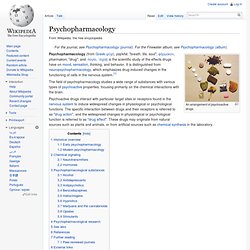
Psychoactive drugs interact with particular target sites or receptors found in the nervous system to induce widespread changes in physiological or psychological functions. The specific interaction between drugs and their receptors is referred to as "drug action", and the widespread changes in physiological or psychological function is referred to as "drug effect".
Cannibinoids. Hypnotics. Hallucinogens. Anti-anxiety medication. Antipsychotics. Antidepressants. Alcohol. History of Psychopharmacology. Psychopharmacology. Psychoactive Alkaloids. Psychoactive drug. An assortment of psychoactive drugs—street drugs and medications: Psychoactive substances often bring about subjective (although these may be objectively observed) changes in consciousness and mood that the user may find rewarding and pleasant (e.g. euphoria or a sense of relaxation) or advantageous (e.g. increased alertness) and are thus reinforcing.
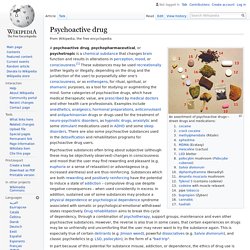
Substances which are both rewarding and positively reinforcing have the potential to induce a state of addiction – compulsive drug use despite negative consequences – when used consistently in excess. In addition, sustained use of some substances may produce a physical dependence or psychological dependence syndrome associated with somatic or psychological-emotional withdrawal states respectively.
Drug rehabilitation aims to break this cycle of dependency, through a combination of psychotherapy, support groups, maintenance and even other psychoactive substances. Drug action. The action of drugs on the human body is called pharmacodynamics , and what the body does with the drug is called pharmacokinetics .
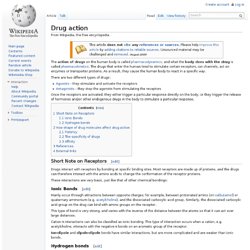
The drugs that enter the human tend to stimulate certain receptors, ion channels, act on enzymes or transporter proteins. As a result, they cause the human body to react in a specific way. There are two different types of drugs: Agonists - they stimulate and activate the receptors Antagonists - they stop the agonists from stimulating the receptors Once the receptors are activated, they either trigger a particular response directly on the body, or they trigger the release of hormones and/or other endogenous drugs in the body to stimulate a particular response. Short Note on Receptors [ edit ] Drugs interact with receptors by bonding at specific binding sites.
These interactions are very basic, just like that of other chemical bondings: Ionic Bonds [ edit ] Cation-π interactions can also be classified as ionic bonding. Narcotic. Heroin , a powerful opioid and narcotic.
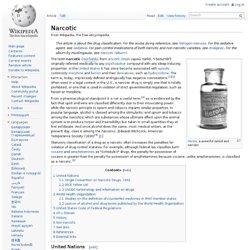
The term narcotic ( / n ɑr ˈ k ɒ t ɨ k / , from ancient Greek ναρκῶ narkō , "Ι benumb") originally referred medically to any psychoactive compound with any sleep-inducing properties. In the United States it has since become associated with opioids , commonly morphine and heroin and their derivatives , such as hydrocodone . The term is, today, imprecisely defined and typically has negative connotations. [ 1 ] [ 2 ] When used in a legal context in the U.S., a narcotic drug is simply one that is totally prohibited, or one that is used in violation of strict governmental regulation, such as heroin or morphine.
From a pharmacological standpoint it is not a useful term, [ 3 ] as is evidenced by the fact that spirit and wine are classified differently due to their intoxicating power; while the narcotic principle to opium and tobacco imparts similar properties. United Nations [ edit ] Single Convention on Narcotic Drugs, 1961 [ edit ] Opiate. For other uses see Opiate (disambiguation) , or for the class of drugs see Opioid .
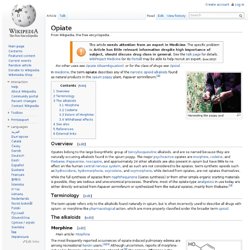
Harvesting the poppy pod. In medicine , the term opiate describes any of the narcotic opioid alkaloids found as natural products in the opium poppy plant, Papaver somniferum . [ 1 ] Overview [ edit ] Opiates belong to the large biosynthetic group of benzylisoquinoline alkaloids, and are so named because they are naturally occurring alkaloids found in the opium poppy. The major psychoactive opiates are morphine , codeine , and thebaine . While the full synthesis of opiates from naphthoquinone (Gates synthesis) or from other simple organic starting materials is possible, they are tedious and uneconomical processes. Psychiatric medication. Efficacy. Ablility to finish a task satisfactorily Efficacy is the ability to perform a task to a satisfactory or expected degree.
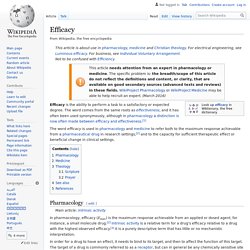
The word comes from the same roots as effectiveness, and it has often been used synonymously, although in pharmacology a distinction is now often made between efficacy and effectiveness.[1] The word efficacy is used in pharmacology and medicine to refer both to the maximum response achievable from a pharmaceutical drug in research settings,[2] and to the capacity for sufficient therapeutic effect or beneficial change in clinical settings. Pharmacology[edit] In pharmacology, efficacy (Emax) is the maximum response achievable from an applied or dosed agent, for instance, a small molecule drug.[2] Intrinsic activity is a relative term for a drug's efficacy relative to a drug with the highest observed efficacy.[3] It is a purely descriptive term that has little or no mechanistic interpretation.
Chemical synthesis. In chemistry , chemical synthesis is a purposeful execution of chemical reactions to get a product , or several products.

This happens by physical and chemical manipulations usually involving one or more reactions. In modern laboratory usage, this tends to imply that the process is reproducible, reliable, and established to work in multiple laboratories. A chemical synthesis begins by selection of compounds that are known as reagents or reactants. Various reaction types can be applied to these to synthesize the product, or an intermediate product.